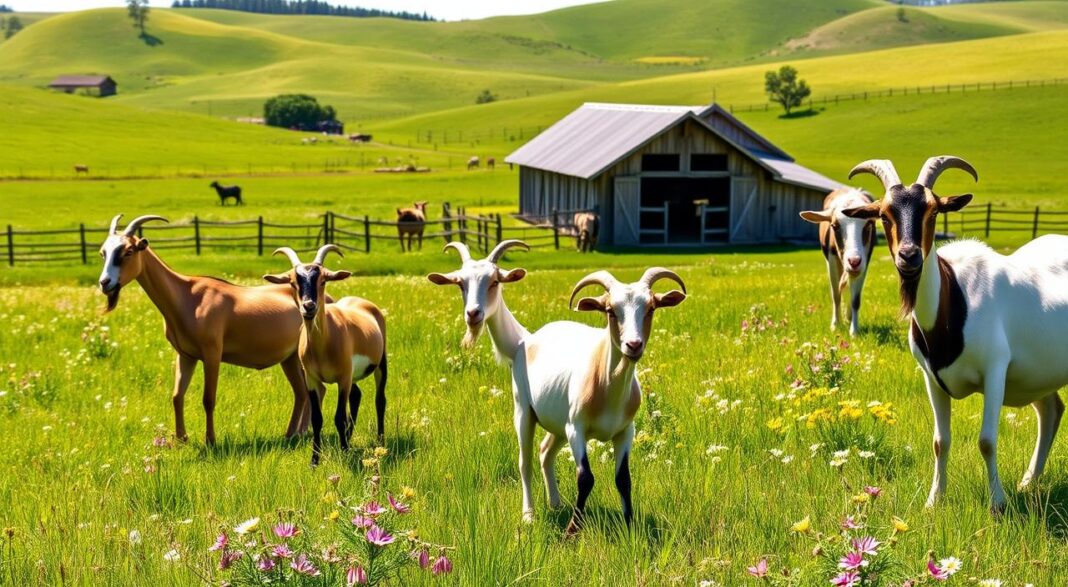Murrah Buffalo Milk Per Day
The Murrah buffalo is famous for its high milk production. It’s a key player in India’s dairy world. A recent study looked into how the Murrah breed’s size and shape affect its milk output.
Researchers studied 100 Murrah buffaloes in their first to third milk cycles. They found out what makes these buffaloes produce so much milk.
The study checked five important traits: how much milk they produce in 305 days, and their muzzle, brisket, hip widths, and skin thickness. They found interesting connections.
They saw that wider muzzles, briskets, and hips mean less milk. But thinner skin means more milk. This info helps farmers and breeders pick the best Murrah buffaloes for milk.
Key points
- Murrah buffaloes are renowned for their exceptional milk production capabilities.
- A study analyzed the correlation between morphometric characteristics and milk production in Murrah buffaloes.
- Negative correlations were found between lactation yield and muzzle width, brisket width, and hip width.
- A positive correlation was observed between lactation yield and skin thinness.
- These insights can guide the selection of Murrah buffaloes with optimal milk production performance.
Introduction to Murrah Buffalo Breed
The Murrah buffalo is a highly valued water buffalo breed from the Indian subcontinent. It’s known for its high milk production and ability to adapt. These animals are found mainly in Haryana and Punjab, India.
They are easy to spot because of their unique features. These include a curved forehead, a short and thick neck, and large, crescent-shaped horns.
Origin and Geographical Distribution
The Murrah buffalo comes from northern India. It’s popular in places like Bhiwani, Agra, and Hisar. It’s also found in Rohtak, Jind, Jhajhar, Fatehabad, Gurgaon, and Delhi.
It’s known for its hardiness in different climates. This makes it a great choice for dairy farmers in India.
Distinguishing Characteristics of Murrah Buffaloes
Murrah buffaloes have unique physical traits. They are strong and muscular, with females weighing 450 kg and males weighing 550 kg. They stand about 1.32 meters tall for females and 1.42 meters for males.
Their most notable feature is their large, crescent-shaped horns. These horns curve up and add to their distinctive look. They also have a convex forehead and a short, thick neck.
These buffaloes are also known for their milk production. They can produce 14-15 liters of milk a day. Some even produce over 18 liters during peak lactation. Their high milk production, disease resistance, and adaptability make them a favorite among dairy farmers.
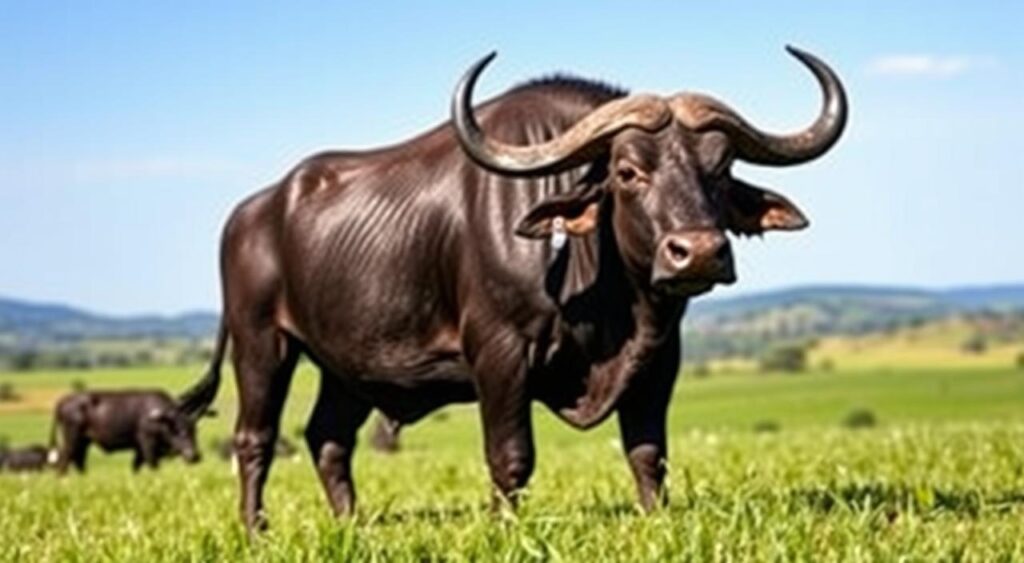
Murrah Buffalo Milk Production
Murrah buffaloes are known for their high milk production. They can produce 8 to 12 liters of milk daily. Some can even reach up to 15 liters a day. This is due to their strong genetics and several other factors.
Average Milk Yield Per Day
Studies show Murrah buffaloes can produce about 2604.8±39.5 kg of milk on average. This makes them a great choice for dairy farming.
Factors Influencing Milk Production
Several things affect how much milk Murrah buffaloes can produce. These include:
- Genetic Factors: The Murrah breed’s genetics are key to their milk production.
- Nutritional Status: Good food and nutrition are important for their milk yield.
- Stage of Lactation: Where they are in their lactation cycle also matters.
- Management Practices: How they are cared for and managed can also affect their milk production.
The study found that body weight, abdominal girth, and muzzle width are positively related to milk yield. But, skin thickness is negatively related.
| Correlation Coefficient | Parameter |
|---|---|
| 0.26 | Milk Yield and Body Weight |
| 0.64 | Milk Yield and Abdominal Girth |
| 0.42 | Milk Yield and Muzzle Width |
| -0.79 | Milk Yield and Skin Thickness |
These findings highlight the importance of considering these factors. They help ensure Murrah buffaloes produce the most milk possible.
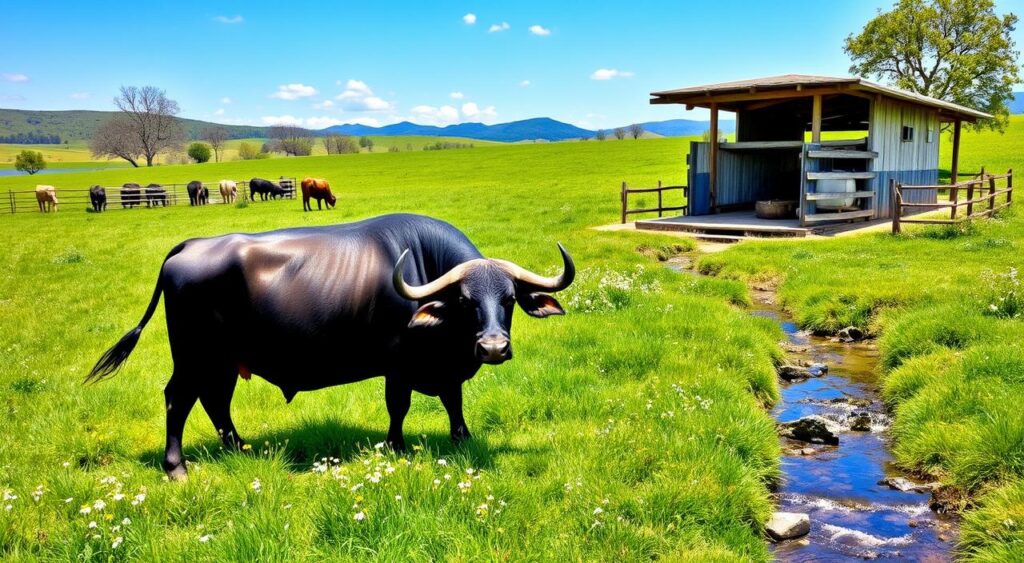
Nutritional Composition of Murrah Buffalo Milk
Murrah buffalo milk is known for its high nutritional value. It has more essential nutrients than cow’s milk. This makes it a great choice for those who care about their health.
Comparison with Cow’s Milk
Murrah buffalo milk has more fat, from 6% to 8%. Cow’s milk usually has 3-4%. It also has more protein, from 4% to 4.5%, compared to cow’s milk’s 3.5%. This means it’s more satisfying and nutritious.
Murrah buffalo milk also has more vitamins and minerals. It has more vitamin B12, calcium, and casein-derived peptides. These help keep bones strong and improve overall health. It’s a better choice for those looking for a healthier milk option.
| Nutrient | Murrah Buffalo Milk | Cow’s Milk |
|---|---|---|
| Fat | 6-8% | 3-4% |
| Protein | 4-4.5% | 3.5% |
| Vitamin B12 | Higher | Lower |
| Calcium | Higher | Lower |
| Casein-derived Peptides | Higher | Lower |
The better nutritional makeup of Murrah buffalo milk makes it a top pick for those who want a healthier milk. It’s a more nutritious option than traditional cow’s milk.
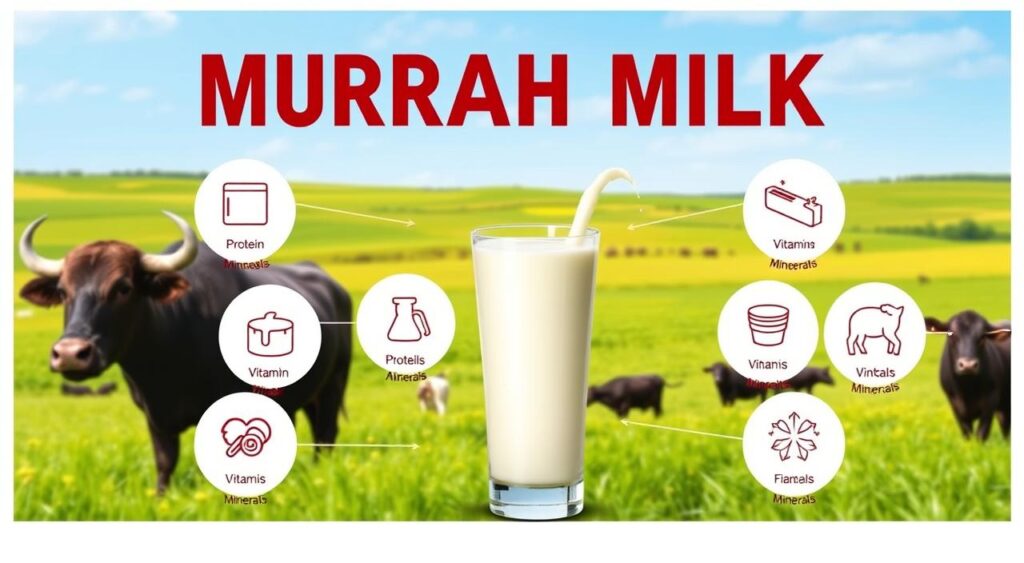
Murrah Buffalo Lactation Cycle and Management
Murrah buffaloes are famous for their high milk production. They have a 310-day gestation period and a 305-day lactation period. These animals are key in the dairy world. Proper care, like breeding and dry-off periods, is essential for their health and milk quality.
The Murrah buffalo’s lactation cycle is complex. Breeding, calving, and dry-off periods are critical. By watching these closely, farmers can keep milk quality high. Knowing the Murrah buffalo’s cycle helps farmers improve their work.
River buffaloes, like Murrah, breed all year. They start breeding at 250-275 kg and first calve between 3-5 years. They have two calves every three years. Lactating females stay in the herd until their ninth lactation, around 16 years old.
| Lactation Cycle Parameter | Murrah Buffalo |
|---|---|
| Gestation Period | 310 days |
| Lactation Period | 305 days |
| Calving Interval | 14-15 months |
| Calves per 3 Years | 2 |
| Breeding Females Retained | Up to 9th Lactation (16 years) |
Understanding the Murrah buffalo’s lactation cycle is key. Effective management leads to better milk production and herd health. This supports the growth of the Murrah buffalo dairy industry.
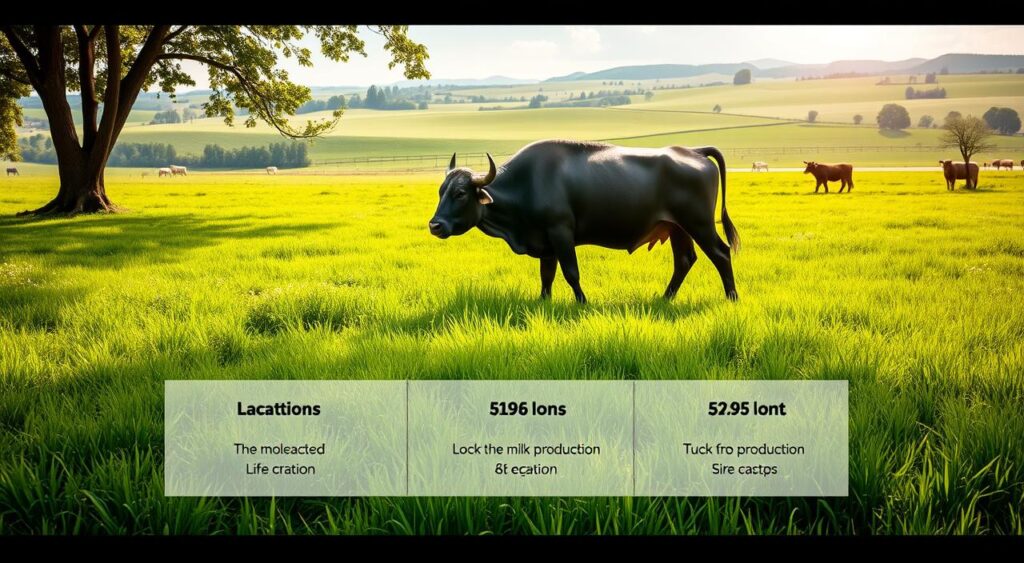
Murrah Buffalo Milk Per Day: Production Insights
The Murrah buffalo is known for its high-quality milk. It can produce 8 to 12 liters of milk daily. In some cases, it can even produce up to 15 liters a day. This high milk production, along with its nutritional value, makes Murrah buffalo milk very popular in the dairy world.
To get the most out of Murrah buffaloes, it’s important to know what affects their milk production. Things like genetics, diet, and health all play a big role. These factors help determine how much milk a Murrah buffalo can produce.
| Factor | Impact on Milk Yield |
|---|---|
| Genetic Traits | Certain genetic variations have been linked to higher milk production in Murrah buffaloes, as revealed by studies on the breed’s genome. |
| Nutrition | A balanced diet rich in essential nutrients, such as proteins, carbohydrates, and minerals, is essential for maintaining optimal murrah buffalo milk per day and dairy yield. |
| Health and Management | Proper healthcare, including routine deworming and vaccination against diseases like hemorrhagic septicemia, along with suitable housing and management practices, can significantly impact the milk production capability of Murrah buffaloes. |
Dairy farmers can increase the murrah buffalo dairy yield by focusing on these key factors. This can lead to a more successful and profitable dairy operation using Murrah buffaloes.

Feeding and Management Practices for Optimal Milk Yield
To get the best milk from Murrah buffaloes, you need a good feeding and management plan. A balanced diet is key. It should meet the special needs of lactating Murrah buffaloes to help them produce more milk.
Balanced Diet and Fodder Requirements
Murrah buffaloes do well on a mix of green fodder, concentrates, and minerals. They can digest roughage better than other animals. This lets them get energy from carbs like fiber and starch.
Their diet should have the right amounts of crude protein, calcium, and phosphorus. These nutrients are important for milk production, bone health, and overall health. It’s also important to keep them hydrated with clean, cool water.
Housing and Healthcare Considerations
Good housing is important for Murrah buffaloes’ productivity. They need space to wallow and protection from bad weather. A comfortable and stress-free home helps keep them healthy and boosts milk production.
Regular vet visits and preventive care are key. Early treatment of diseases helps avoid problems like thermal stress. This can lower milk yield in these hardy animals.
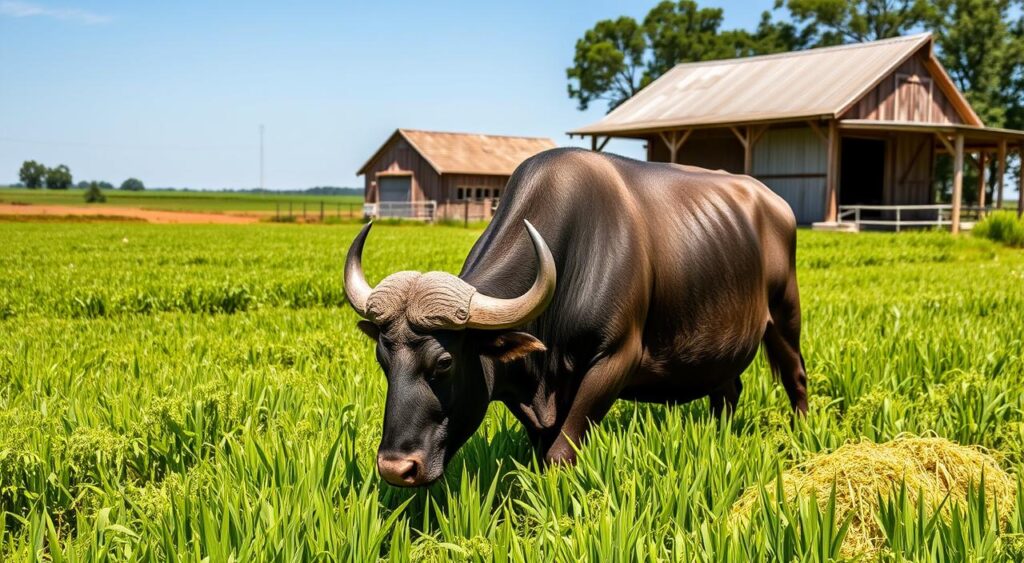
Murrah Buffalo Milk Processing and Value-Addition
Murrah buffalo milk is rich and creamy, perfect for making dairy products. It has more fat and protein than cow’s milk. This means you can make more cheese, yogurt, and butter from it.
Processing Murrah buffalo milk leads to premium murrah buffalo milk processing and value-added murrah buffalo dairy products. These products meet the needs of consumers looking for nutritious and tasty options.
Cheese like Domiati, Kariech, Feta, Cheddar, Swiss, Cottage, and Mozzarella are made in higher quantities from buffalo milk. Mozzarella, for example, can yield 20 to 22 kg per 100 liters of milk. This is almost 50% more than from cow milk.
Cheeses from buffalo milk are also more stretchy and have better texture during ripening.
| Dairy Product | Yield from Buffalo Milk | Yield from Cow Milk |
|---|---|---|
| Mozzarella Cheese | 20-22 kg/100 L | 13-15 kg/100 L |
| Cottage Cheese | Higher fat, protein, and yield | Lower fat, protein, and yield |
| Domiati Cheese | Preferred due to faster coagulation | Less preferred |
Buffalo milk is also used to make Queso Blanco, Mascarpone, and Cheddar cheeses. The dairy industry can offer a wide range of high-quality, nutritious, and flavorful products. This is thanks to Murrah buffalo milk processing and value-addition.

Economic Significance of Murrah Buffalo Dairy Farming
Murrah buffalo dairy farming is very important in India, mainly in Haryana and Punjab. It helps many small and big dairy farmers make a living. The high-quality milk from Murrah buffaloes also leads to more income through dairy products.
Income Generation and Livelihood Opportunities
Murrah buffalo farming is key for jobs and income in rural India. It’s shown that Murrah buffaloes make more money per day than other types. This is true for both daily income and net profit.
The cost to produce milk is also lower with Murrah buffaloes. This makes farming them more profitable and sustainable. It’s a good choice for farmers in India.
| Parameter | Murrah Buffaloes | Graded Murrah | Local Buffaloes |
|---|---|---|---|
| Average Milk Yield per Day (kg) | 11.90 | 11.80 | 10.20 |
| Feed Cost per Buffalo per Day (Rs.) | 217.50 | 315.10 | 250.00 |
| Total Milk Production in Days (kg) | 6197.10 | 6835.00 | 5700.00 |
| Feed Cost per kg of Milk (Rs.) | 19.15 | 25.20 | 22.00 |
| Average Gross Income per Day (Rs.) | 411.80 | 331.62 | 254.53 |
| Average Net Income per Day (Rs.) | 144.40 | 114.56 | 72.99 |
Murrah buffalo milk is a big part of India’s milk production. It makes up 55% of the country’s milk, even though there are fewer Murrah buffaloes. India’s milk production is growing faster than the world’s, at 4.2% annually.
Challenges and Future Prospects
Murrah buffaloes are known for their high milk production. But, dairy farming in India has many challenges. One big issue is the need for better breeding programs to improve genetic diversity and milk yield.
Dairy farmers also face problems getting quality feed and healthcare for their animals. This can greatly affect milk production.
Another challenge is the lack of efficient milk processing infrastructure. Many rural areas don’t have the right facilities to handle, store, and process Murrah buffalo milk. This leads to milk waste and hurts the dairy industry’s economic growth.
But, there’s hope for Murrah buffalo milk and its products. The growing demand for quality dairy products worldwide presents opportunities for sustainable growth and economic development in rural areas.
To fully realize the benefits of Murrah buffalo dairy farming, we need a coordinated effort. More investment in research, policy changes, and technology can help overcome current obstacles. This will ensure a strong Murrah buffalo dairy industry in India.
By tackling the challenges in murrah buffalo dairy farming and seizing the future prospects of murrah buffalo milk production, the dairy sector can boost food security, improve rural livelihoods, and enhance the country’s economic health.
Conclusion
The Murrah buffalo is a top dairy breed worldwide. It produces 8 to 12 liters of milk daily, with some reaching 15 liters. This makes it a key player in the dairy market.
Murrah buffalo milk is rich in nutrients. It’s also great for processing, making it very popular. This has boosted its value in the dairy world.
Knowing what affects milk production is key. Factors like size and skin thickness play a role. Farmers can use this knowledge to improve milk output.
In India, buffalo milk is a big deal. It’s full of fat and solids, helping the country’s milk production. This shows how important Murrah buffaloes are to the dairy sector.
The Murrah buffalo’s popularity is growing. India’s buffalo population is increasing by 1.0% each year. This growth is good for dairy farming and the economy.
To keep this growth going, we need to tackle challenges. We aim to reach 191 million tons of milk by 2020. This will help Murrah buffaloes reach their full dairy promise.



